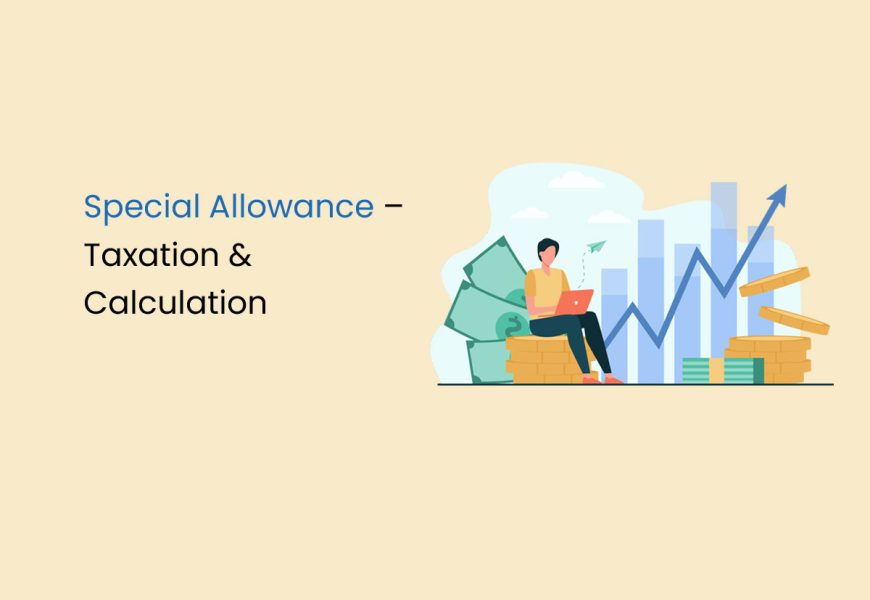Special allowances emerge as pivotal components designed to cater to diverse needs within organizations. These designated sums of money disbursed beyond an individual’s basic salary, serve a lot of purposes, ranging from recognizing performance to addressing specific requirements. Whether within expansive corporations or sole proprietorships, the prevalence of special allowances underscores their significance across the business spectrum.
Linked intricately to an employee’s basic salary, these allowances, exemplified by categories like LTA (Leave Travel Allowance) and HRA (House Rent Allowance), comprise tax-exempt and taxable components. The tax implications are contingent upon the nature and purpose of the allowance, adding a layer of complexity to their administration.
As we delve into the intricacies of special allowances, it becomes evident that these financial supplements are subject to dynamic fluctuations. The ebb and flow of such allowances are influenced not only by an employee’s position and performance but also by an organization’s fiscal health and the contours of existing employee benefit programs. In this article, we will discuss everything related to special allowances, so, let’s dive in!
What is a Special allowance?
Special allowances can be different from one company to another. Some companies give it as a ‘bonus’ to appreciate good work, while others tie it to the company’s profit, following rules in the Income Tax Act of 1962.
When a company rewards outstanding performance with an allowance, that amount is often tax-free up to a certain limit.
In some salary structures, special allowances are listed separately. After taking out things like travel allowances and rent allowances, what’s left is called a unique allowance. This amount doesn’t fall under other expenses and is what remains after calculating an employee’s total compensation.
There are rules about these allowances. For example, money set aside by an employer for a specific expense is exempt from Income Tax under Section 17(2) of the IT Act, 1961, but it needs to be paid while the employee is actively working.
It’s important to understand the difference between allowances and perks. Companies might reward high-performing employees with better salaries or stock options. They can also provide additional benefits like allowances to help their employees maintain their standard of living. In both cases, the money given is not taxed.
Taxation in Allowance
Allowances and taxation are intricately connected, with specific rules outlined to determine whether an allowance is taxable or not. The Income Tax Act of 1961 provides exemptions for certain allowances under Section 10(14).
Several conditions define when extraordinary allowances are not taxable, as specified in relevant sections of the Income Tax Act:
- Exemptions apply only if the allowance is not considered a prerequisite. This distinction is crucial and applies solely to permanent employees.
- Exemptions are granted for advances that are solely and wholly intended for outstanding job performance by individuals holding offices of profit.
- Any payments of a personal nature or with a personal angle are not eligible for tax exemption.
- Importantly, there is no upper limit specified for allowances as per the law.
In addition to these general principles, specific tax laws address certain scenarios:
- No tax is levied on advances or payments to the Honourable Justices of the High Courts and the Supreme Court.
- If a company’s structure includes a House Rent Allowance (HRA), partial tax exemption is available under Section 10(13A).
- However, certain allowances, such as city compensatory allowance, are never exempt from taxation.
It’s noteworthy that the laws governing Dearness Allowance (DA) automatically factor in, considering different cities with varying living costs. This reflects the dynamic nature of allowances and taxation systems, incorporating specific exemptions and regulations for different circumstances.
Categories of Special Allowances
Special allowances and advances come in various types, catering to both personal and official needs. It’s crucial to note that these allowances are typically monthly and are subject to taxation as per the corresponding Income Tax (IT) sections.
Here’s an overview of different categories of extraordinary allowances for personal purposes:
| Allowance Type | Exemption Limit | Tax Implications |
|---|---|---|
| Child Education Allowance | Rs. 100 per child for a 2-child family | Excess amount beyond the limit is taxable |
| Hostel Expenditure Allowance | Rs. 300 per child for 2 children in a family | Any excess amount is taxable |
| Transport Allowance for Handicapped Employees | Rs. 1600 a month / Rs. 3200 a month for handicapped | Rest or excess beyond the limit is taxable |
| Conveyance Allowance for Rail, Water, and Roadways | 70% of the total amount received is exempt | 30% of the amount is taxable |
| Special Allowance for Armed Forces Personnel (Stationed in Lakshadweep or Andaman & Nicobar Islands) | Maximum Rs. 3250 a month | No Income Tax, except on savings |
These are some other categories under special allowances:
- Tribal Area Allowance: Provided to residents of hilly, scheduled, and agency areas (e.g., Uttar Pradesh, Karnataka). Exemption of up to Rs.200 per month.
- Outstation Allowance: Offered by roadways, railways, and airways instead of daily allowance. The exemption is 70% of the allowance or Rs.10,000, whichever is lower.
- Hostel Allowance: Exemption of up to Rs.300 per month per child for two children.
- Uniform Allowance: Allowance for expenses related to purchasing and maintaining the required uniform for employment.
- Academic/Research Allowance: Encourages research/training in research institutions.
- Travelling Allowance: Supplements the cost of travel during tours or duty transfers to another city.
- Daily Allowance: Covers daily charges incurred when on a tour.
- Helper Allowance: Allows reimbursement for expenses incurred when hiring an assistant to fulfil employment duties.
These categories highlight the diversity of special allowances, each serving a distinct purpose and offering specific exemptions to eligible individuals.
Special allowance categories are an integral part of gross salary, and their allocation varies based on company policies. It’s crucial to understand that if one company provides a special allowance to all its employees, it doesn’t necessitate that another company do the same.
To determine the total amount received under the special allowance component, individuals need to sum up the figures provided under each eligible allowance head. This information is typically available on the salary slip, providing a breakdown of the allocation towards special allowances.
Example
Let’s consider two scenarios:
1. Ms. V at Company A
Ms. V, an employee at Company A, checks her salary slip and discovers a monthly conveyance allowance of Rs.1,600. This allowance is intended to cover travel expenses from her place of residence to her place of work.
2. Mr. C, a Medical Practitioner in the Public Sector
Mr. C, a medical practitioner working in the public sector, is deployed for duty at a medical camp in the rural side of Bidar, Karnataka, inhabited by tribes. In this case, Mr. C receives an additional component in his salary – tribal area allowance.
Understanding the specifics of special allowance categories is essential for individuals to comprehend their overall compensation structure and make informed financial decisions.
Special Allowance Calculation
Gross Salary Components
- Gross Pay: Total pay before deductions and taxation.
- Basic Salary (40% of CTC): Fully taxable.
- DA (20% of basic salary): Usually taxable, depending on company policy.
- HRA (50% of basic): Applicable for those living in rented houses.
- Medical Reimbursement: Fixed amount per month (e.g., Rs. 1250).
- LTA: Depends on the company policy, exempt up to a certain limit on bill submission.
- Special Allowance: Depends on company policy, generally taxable.
- Food Coupon: Based on company regulations.
Variable Components
- Performance-Based Bonus (8.33 to 20% of gross).
- Employer’s Contribution to PF (13.61% of basic).
- Mediclaim: Varies from company to company.
- Gratuity: Depends on company norms.
CTC (Cost to Company)
- CTC is the sum of gross pay and variable components.
Deductions
- Employee’s Contribution to PF.
- TDS (Tax Deducted at Source).
- Professional Tax.
Example
Sanjeev Bhatia, a 30-year-old advertising executive, has a CTC of Rs. 4.75 lakh. The breakdown of his salary, including special allowance, is as follows:
- Basic Salary: Rs. 14,000
- HRA: Rs. 7,000
- Medical Reimbursement: Rs. 1,250
- Special Allowance: Rs. 9,570
- CTC: Rs. 39,596 (per month) / Rs. 4,75,152 (per annum)
FAQs on Special Allowance
Why Do Companies Provide Special Allowances?
Companies offer special allowances to fulfill various objectives, including recognizing outstanding performance, addressing specific needs of employees, or as part of the overall compensation structure. It is a way for organizations to provide additional financial support beyond the basic salary.
Is Special Allowance the Same Across Different Business Entities?
Yes, special allowances are found in all types of business entities, ranging from large corporations to sole proprietorships. However, the specific amounts and purposes of special allowances may vary based on the policies and financial health of each organization.
How is Special Allowance Different from Basic Salary?
Special allowance is separate from the basic salary and is often provided on top of the regular compensation. While the basic salary forms the core of an employee's earnings, the special allowance is an additional amount with a specific purpose.
Are Special Allowances Taxable?
The tax treatment of special allowances varies, and it depends on the nature and purpose of the allowance. Some components of special allowances may be tax-exempt, while others may be taxable. Exemptions are often based on specific criteria and regulations outlined in tax laws.
What is the Distinction Between Taxable and Exempt Allowances?
Allowances can be categorized into taxable and exempt. Exempt allowances further fall into:
- Exemption based on a specific computation method.
- Exemption based on the lower of the allowance amount or the amount spent for the specified purpose.
- Exemption based on the prescribed amount or the lower of the allowance.
How Do Allowances Differ from Perquisites?
Allowances refer to the money received by an employee for various purposes, while perquisites are facilities offered by employers, such as housing or a car.
Is special allowance distinct from dearness allowance?
Yes, dearness allowance and special allowance are difference and not interchangeable terms. Special allowances encompass various components such as leave travel allowance, medical allowance, conveyance allowance, among others. It's important to note that special allowances are applicable to employees in both the public and private sectors.





















